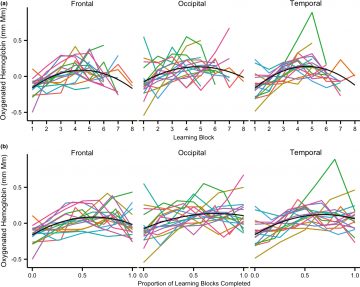How do babies learn to perceive the world around them?
As an adult, seeing is so easy right? We just open our eyes! And to hear, we just have to be within earshot. Well although it may seem effortless, these perceptual abilities (hearing, seeing, touching) are supported by our highly specialized brain and the process is complicated.
Importantly, we are not born with the ability to see and hear as well as adults can. Babies must learn how to see, hear, and get information about the world through their senses. A major focus for our lab is the investigation of how a baby’s ability to learn helps them see. How does learning about something new help a baby to see it better?
So far, we’ve found that in a couple of minutes, a baby can learn to change their visual system (the part of the brain that processes what they see; Emberson, 2019). We are still learning more about how fast and flexible a baby’s brain is by using a method called functional near-infrared spectroscopy (fNIRS) which is entirely safe and comfortable for infants. (To learn more about fNIRS, check out our FAQ!)

How do babies learn from their everyday experiences?
A key part of an infant’s everyday experience is the presence of statistical information. Infants can use this information to learn about their environment by understanding what is typical in the world. For example, after hearing a bark, there is a higher probability of seeing a dog than a cat.
Statistical information is always around and gives an infant key information about their environment. We also know that infants can use this information to learn starting from their first months of life (Emberson, Misyak, Schwade, Christiansen, & Goldstein, 2019). In the Baby Learning Lab, we investigate how statistical learning operates and how an infant uses statistical information to shape their brain (Emberson, Boldin, Robertson, Cannon, & Aslin, 2019; Emberson, Richards, & Aslin, 2015; Zhang, Jaffe-Dax, Wilson, & Emberson, 2019).
 We’ve found that over just a few minutes of learning new information, infants experience a rise in their neural responses, followed by a reduction or leveling-off in their neural responses (Kersey & Emberson, 2017). These inverted U-shaped neural learning trajectories (as seen in the figure on the right) are related to an infant’s ability to remember this new piece of information: The more an infant’s neural patterns follow this trajectory, the better an infant’s brain remembers. We’ve also found that premature infants exhibit variations of these neural changes (Jaffe-Dax, Boldin, Daw, & Emberson, 2019). Investigating these neural signatures of learning is one of the ways that we’re uncovering how exposure to statistical information and learning shapes the developing brain.
We’ve found that over just a few minutes of learning new information, infants experience a rise in their neural responses, followed by a reduction or leveling-off in their neural responses (Kersey & Emberson, 2017). These inverted U-shaped neural learning trajectories (as seen in the figure on the right) are related to an infant’s ability to remember this new piece of information: The more an infant’s neural patterns follow this trajectory, the better an infant’s brain remembers. We’ve also found that premature infants exhibit variations of these neural changes (Jaffe-Dax, Boldin, Daw, & Emberson, 2019). Investigating these neural signatures of learning is one of the ways that we’re uncovering how exposure to statistical information and learning shapes the developing brain.